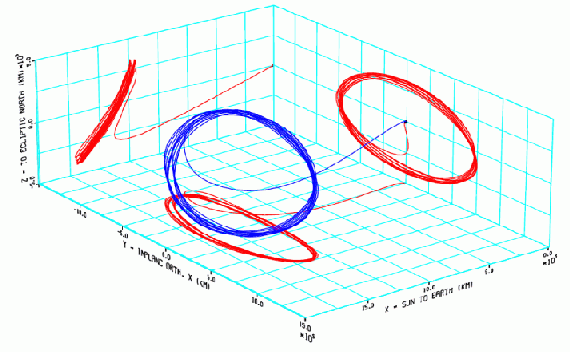
Figure 2.6. Left: Position of the Lagrange points for the Sun-Earth/Moon system. L2 lies 1.5 million kilometres from Earth. Right: An example of a Lissajous orbit around L2. The orbit x and y-axis are as shown in the plot on the left, the z-axis is normal to paper.
The Herschel spacecraft was eventually placed in a large "halo" orbit around L2 (halo orbits are special cases of Lissajous orbits around Lagrange points where the in-plane and out-of-plane frequencies are the same), with an amplitude of about 700 000-km and a period of approximately 178 days. The distance from the Earth ranges from 1.2 to 1.8 million km.
The orbit chosen for Herschel presents a number of advantages summarised below:
Simplifies long observations, since the Sun and the Earth remain close to each other as seen by the S/C (Sun-S/C-Earth angle always < 40°)
Very stable thermal and radiation environment
No trace of atmosphere
A large halo orbit can be achieved without any injection Δv
Major drawbacks are the long distance for communications and the fact that orbits around the L2 are unstable; without orbit corrections the spacecraft would deviate exponentially from the nominal one. Small correction manoeuvres, applied at approximately monthly intervals, maintain the orbit close to the nominal one. Figure 2.7 shows an example of large halo orbit around L2 (from [RD2]).

Figure 2.7. A 3D representation of a large halo orbit around L2. The Earth is located at (0,0,0). Red tracks are the projection on the three orthogonal planes of the 3D orbit (blue track).
Herschel operations are performed by the European Space Operations Centre (ESOC) located in Darmstadt (Germany). The main ground station is New Norcia (Australia), which is equipped with a a 35-metre antenna using X band up and down links. New Norcia is backed up by the Cebreros ground station (Spain). In the phase immediately after launch the Kourou (French Guiana) and Villafranca (Spain) ground stations were also used. During routine operations, the ground station communication link is restricted to a duration of approximately 3 hours. During this time, the spacecraft antenna is be pointed to the Earth. The data stored in the on-board solid state mass memory are downlinked, and the mission time line with the new schedule is uplinked. Real time operations and spacecraft maintenance are also carried out during this period. The rest of the time the satellite operates autonomously. The system has been designed to support 48 hours of autonomous operation, with requires a solid state mass memory capability of 25 Gbt. The amount of Herschel data downloaded per day is in excess of 8 Gbt.